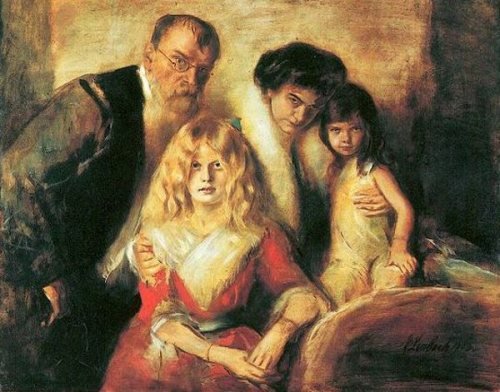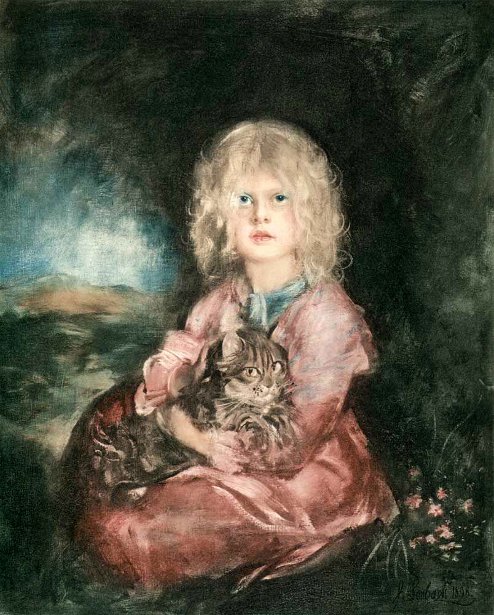
Städtische Galerie im Lenbachhaus
My recent blogs have in some ways been connected. I will be in the middle of researching one artist when I come across another, who I feel I just cannot ignore and so my next featured artist has already been decided upon before I have completed my research on the current one. A few blogs back I looked at the life of Frida Kahlo. Whilst looking at literature concerning her and other female artists I came across Gabriele Münter and from her I focused on her one-time lover Wassily Kandinsky. On looking at his life I found that one of his early art tutors was Franz von Stuck and he was the subject of my last blog. I had decided to stop this train of thought when choosing a new artist but then during my research on von Stuck I stumbled across a contemporary of his, Franz von Lenbach and although I had decided to stop this system of choosing artists I found his portraiture awesome, especially his depiction of his own family. I just could not pass up the chance of introducing this German painter to you and share with you some of his wonderful family portraiture.

Franz Lenbach or to give him his full title, after ennoblement, Franz-Seraph Ritter von Lenbach was born in 1836 in the small town of Schrobenhausen which lies about forty miles north of Munich. His father was a master builder and stonemason. Initially Franz had planned to follow in his father’s footsteps and become a master builder himself and accordingly in his early teens, he enrolled at the Landshut Technical College to study the art of stone masonry and architecture. At the age of fifteen he began to concentrate on sculpture and started to work in the studios of the German sculptor, Anselm Sickinger. If it had not been for his elder brother, Karl August Lenbach, who was a painter, then maybe Franz would have carried on in his father’s profession. However his brother introduced him to John Baptist Hofner, the German painter of animal and genre scenes and who had previously studied at the Akademie der Bildenden Künsten in Munich and it was he who introduced Franz Lenbach to drawing and painting. Hofner and Franz Lenbach would often spend time going off together on painting trips and Hofner taught Lenbach the skills of en plein air painting.

For Franz Lenbach to gain admission to the Akademie der Bildenden Künsten he needed some formal groundwork training in art and so, in 1852, at the age of sixteen, he enrolled at the Polytechnische Schule in Augsburg, following which he trained in the studio of Albert Gräfle, the Munich portraitist. Finally Franz enrolled at the Munich Academy of Fine Arts in 1854. Three years later he was studying under the great German historical painter Karl Theodore Piloty. From the sale of one of Lenbach’s works, Peasants Trying to Take Shelter from a Thunderstorm in a Chapel and a scholarship, he managed to accumulate enough funds to go Rome with Piloty and Piloty’s brother Ferdinand, who was also an artist. So impressed was Theodor Piloty with the artistic talents of Lenbach that in 1860, he put Lenbach’s name forward for the post of professorship of the Kunstschule in Weimar, which had just been opened. Lenbach took the position and remained there for two years but by the end of this tenure he realised that life in academia as an art professor was not for him.

It was around this time that Franz Lenbach met Adolf Friedrich, Graf von Schack, who was a German poet, historian of literature and an avid art collector. Schack had wanted to build up a formidable art collection for himself and although extremely wealthy he could not afford to buy paintings by the Old Italian Masters so he approached Lenbach and other aspiring young artists to set about copying some of his favourites. Once Lenbach agreed to carry out this commission he was sent to Rome to start copying some of the famous works. Here he met some other artists, such as Arnold Böcklin and Anselm Feuerbach who had also been commissioned as copyists by Schack. So pleased was Schack with what Lenbach produced he sent him to Florence in 1865 to carry on the good work.

Whilst working in Florence Lenbach met Karl Eduard Baron von Liphart, a central figure of the German expatriate art colony in Florence, and it was through him that Lenbach picked up some lucrative portraiture commissions. From Florence he travelled to Spain in 1867 with Ernst von Liphart the son of his benefactor. The following year he and Liphart along with his patron, von Schack went to Tangiers. When he returned from North Africa he moved to Vienna and began to concentrate on his portraiture work. Many famous people sat for Lenbach including Richard Wagner, Emperor Franz Joseph I, Ludwig I, King of Bavaria, Emperor Wilhelm I and he completed almost a hundred portraits of Otto Fürst Bismark. It was during this period that Lenbach became recognised as the most famous contemporary German portrait painter.

Munich
In 1882 Franz Lenbach was ennobled, and became known as Franz von Lenbach. Four years later in 1886 he procured himself an estate in Munich and with the assistance of his friend Gabriel von Seidl, the German architect, he designed and had built a Florentine villa which took almost four years to complete. The city of Munich acquired the building in 1924, and today, the Lenbachhaus houses the city’s gallery. In 1900 he won the Grand Prix for painting in Paris. Lenbach died in Munich on May 6, 1904, aged 67.
My featured paintings today are not the ones Lenbach did of famous politicians and rulers of various countries but the intimate portraits of his family. Lenbach had married twice and had three daughters, Marion, Erica and Gabriele. His daughters and his second wife, Charlotte (Lolo) Freiin von Hornstein appear as models in many of his paintings and it some of these beautiful portraits that I have included in today’s blog.
